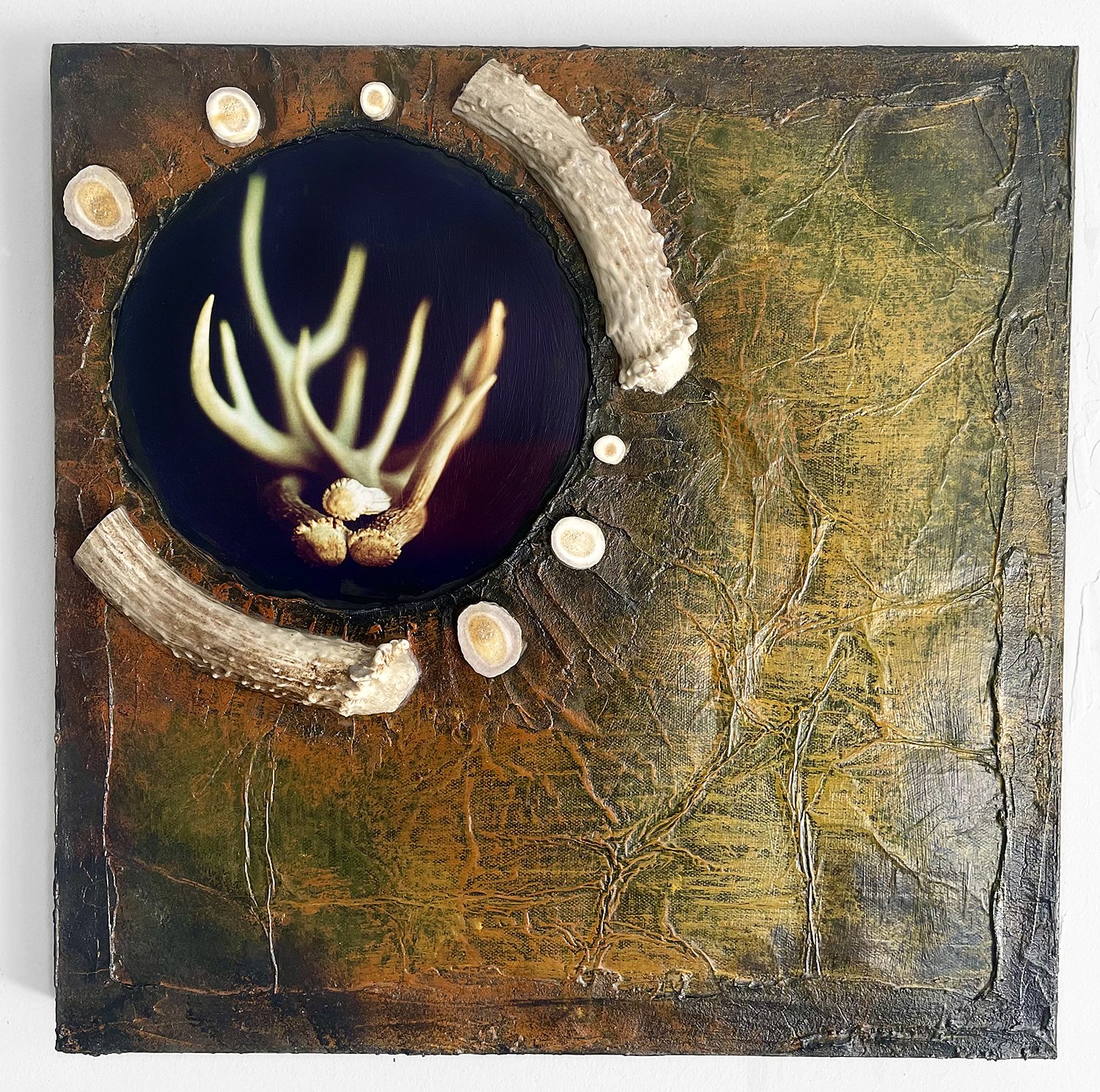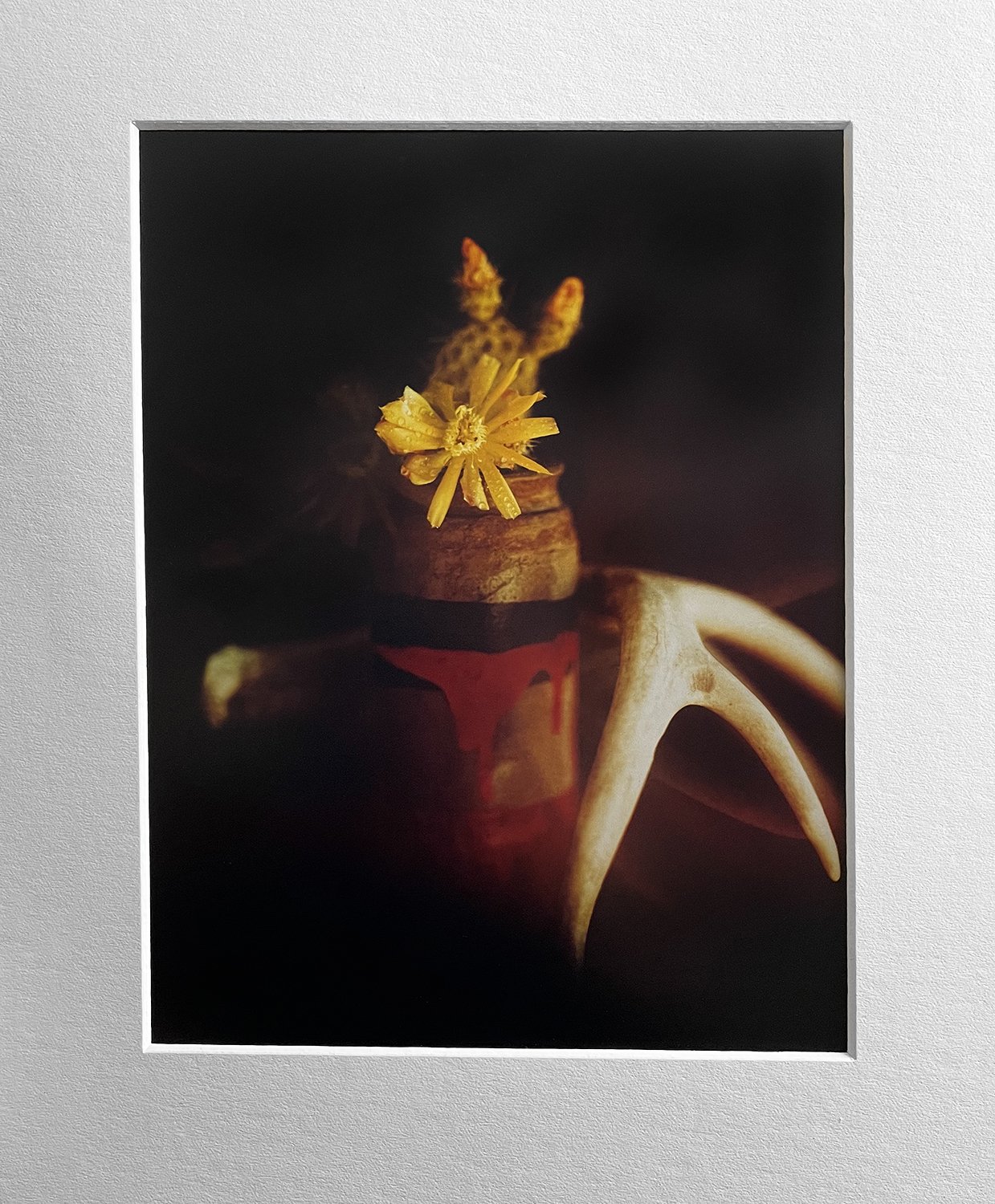A while ago, I decided I needed to take this work to the next level. I needed to address questions surrounding something “missing” in the work. I wrote an essay a few weeks ago about searching for words like “tactile” and “tangible,” as well as enhancing color—all in the service of decay and impermanence. I wanted to engage the work in an interdisciplinary way—deeper and more involved than simply looking at a photograph. I want to create something that asks to be touched and experienced beyond photography. My goal is to transcend photography and create a “living” piece of art that represents this land, the people that were here, and the theories I’m addressing surrounding all of it.
Colors and Textures: I’ve mimicked the colors of fall as well as the colors found in the antlers. The surface of the canvas is a reminder (in the shapes) of the antlers as well as roots or veins reaching into the earth. The colors and textures in this piece worked very well together. It is tactile, physical, and contains real objects from the land. The antlers on the canvas are the antlers (some of them) in the photograph. It’s also a reference to the Ute’s skillful tanning of buckskin (deer hides). They were known for the quality and beauty of the leather they made.
Canvas Choice (18” x 18" - 45,75 x 45,75cm): It’s simple; the canvas represents the shape of the state of Colorado. I did the same thing when I made the Ghost Dance work: 6” x 6” wet collodion negatives and prints. I just carried that concept over to this project.
Fibonacci Sequences: Living on this mountain for the past three years, I’ve become closer to nature. I go to bed when the sun sets, and I get up when it rises. I’m aware of the seasons like never before. I see plants and animals in all stages of their lives. The flow and balance of nature are both awe-inspiring and beautiful. I’m beyond grateful to have experienced this. I’ve spent a lot of time photographing flora. I can see the patterns and the consistency in them. I studied the Fibonacci sequence and became very interested in it. I’ve posted about it before. I’ve designed these mixed media pieces based on the Goldaen Ratio and Fibonacci sequences. This is the only time I’m going to point out the details in a piece. The photograph has 10 antler tips and 3 bases—that’s 13. The antlers and antler buttons surrounding the image represent the number 8. The layout is on the Golden Ratio grid. You get it.
Symbolism of Circles: The Tabeguache Ute always set up a medicine wheel, or the circle of life, at each camp when they traveled in the spring and fall. For them, it represents the continuous pattern of life and death, the paths of the sun and moon, as well as the shape of the earth and moon, among many other things. I’ve used the idea of circles as a way to recognize that and to give a sense of peering into something eternal yet impermanent—a visual paradox. The Circle of Life is a central theme of Ute life. The Ute people have a unique relationship with the land, plants, and all things living. The Circle of Life represents the unique relationship in its shape, colors, and reference to the number four, which represents ideas and qualities for the existence of life.
I found this in a presentation to Colorado 4th graders. The People of the early Ute Tribes lived a life in harmony with nature, each other, and all of life. The Circle of Life symbolizes all aspects of life. The Circle represents the Cycle of Life from birth to death for people, animals, all creatures, and plants. The early Tabegucahe Utes understood this cycle. They saw its reflection in all things. This brought them great wisdom and comfort. The Eagle is the spiritual guide of the People and of all things. Traditionally, the Eagle appears in the middle of the Circle.
The Circle is divided into four sections. In the Circle of Life, each section represents a season: spring is red, summer is yellow, fall is white, and winter is black. The Circle of Life joins together the seasonal cycles and the life cycles. Spring represents Infancy, a time of birth and newness—the time of “Spring Moon, Bear Goes Out.” Summer is Youth. This is a time of curiosity, dancing, and singing. Fall represents Adulthood, the time of manhood and womanhood. This is the time of harvesting and of change: “When Trees Turn Yellow” and “Falling Leaf Time.” Winter begins with gaining wisdom and knowledge about “Cold Weather Here.” Winter represents old age, a time to prepare for passing into the spirit world.
The Circle also symbolizes the annual journey of the People. On this journey, the People moved from their winter camp to the mountains in the spring. They followed trails known to each family group for generations. The People journeyed to each family group for generations. The People journeyed as the animals did. Following the snowmelt, they traveled up to their summer camps. In the fall, as the weather changed, the People began their journey back to their winter camps. Once again, they followed the animal migrations into lower elevations. They camped near streams, rivers, springs, and lakes. These regions provided winter shelter and warmth.
The early People carried with them an intricate knowledge of nature. They understood how to receive the rich and abundant gifts that the Earth, Sky, and Spirit provided. They also understood how to sustain these gifts. They took only what was needed. The People used the plants, animals, and earth wisely. They gave gifts in return. This knowledge was the People’s wealth.
The Circle of Life is the rich cultural and spiritual heritage of the Tabegucahe Ute. This heritage is still alive in the life cycle and seasonal cycles of today. It still is alive within the harmony of nature. It is reflected in the acknowledgement and practice of honoring and respecting all things, people, and relationships. The Circle design can be found on the back of traditionally made hand drums. These drums are important ceremonial instruments for the People today.
The idea of impermanence and decay plays a big role in my approach to this work. I've tried to develop a deeper appreciation of impermanence, specifically of my own impermanence. It’s important for me to try to make the viewer aware of their mortality through these pieces and the theories they’re based on. Everything I’ve made images of is either dead or changing in some way (entropy). The way I’m building these pieces up—the textures and colors—refers to the idea of both death and decay (impermanence) and life and living. An elevated sense of gratitude for every fleeting moment of life is very important to have. It fosters a significant recognition of the invaluable essence of human existence by observing the natural endings in everyday life, like leaves falling from trees or the decay of organic matter. This helps people connect with the concepts of impermanence and death on a smaller scale. That’s the big connection between my work and these theories.
I find myself contemplating compassion more while doing this work. Thinking about my own struggles with difference. I suppose the wonderful thing about learning about these theories (death anxiety and terror management theory) is that you have a lot of time to think about, or even meditate about, your own death and the deaths of loved ones. In turn, that allows you to come to terms, in some ways, with all of it. Moreover, I’ve found I have a heightened zest for life. A greater appreciation for the cycle of life, or, as the Tabeguache Ute would call it, the Circle of Life.
Currently working on monotypes: I’ve been working with acrylic paint and doing monotypes. I really like them; they have a lot of potential for this project. As time goes on, I’ll post some occasionally. I just wanted to share this mixed media idea I had and my thinking around it.





























